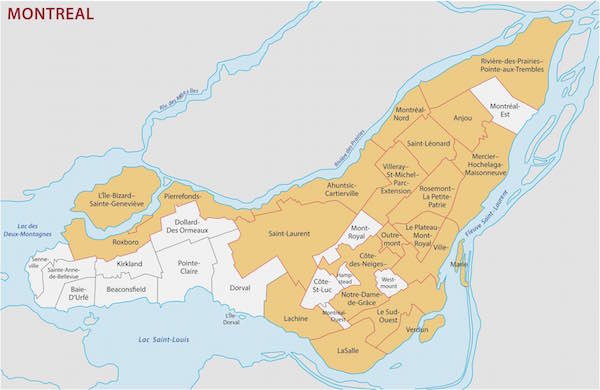
When someone asks a Montrealer what neighbourhood they live in, they usually say LaSalle, NDG, downtown, Le Plateau, or something of the sort.
Turns out, these are actually some of Montreal’s 19 boroughs. Not neighbourhoods.
“What’s the difference?” you may ask.
That’s what we aimed to find out.
- You might also like:
- Here's why Montreal has so many of these bizarre looking spiral staircases
- 10 "Franglais" slang terms that only make sense in Montreal
- Here are the top-rated restaurants in different Montreal neighbourhoods
- A local's guide to Montreal neighbourhoods
“Basically, what it comes down to — in a nutshell — is that a neighbourhood has no political power, but a borough does” says local tour guide and Montreal expert Thom Seivewright. “Boroughs are delimited by borders that were created by politicians, whereas neighbourhoods have borders that were created by neighbourhood development.”
Another difference is that a neighbourhood, such as Little Italy, will not have a mayor, but a borough such as its surrounding Rosemont-La Petite-Patrie does.
This lack of specific borders becomes prominent in certain areas though. For example, take the confusion surrounding where Griffintown ends and Little Burgundy begins. Another debated topic is the actual size of the downtown area. Where does it conclude? Seivewright says the answers to these questions have changed over the years and depend on who you ask.
“Everyone has their own definition of what constitutes downtown but the neighbourhood has no official border,” says the tour guide, adding that his version of downtown consists of “Atwater to the West, Papineau to the East, the river and canal to the South, and Pine and the mountain to the North”.
These borders can be confusing to Montrealers since the clear separation of boroughs has not been around for very long. Before 2001, the island of Montreal was divided into the City of Montreal and its 27 smaller municipalities. But as of 2002, all 28 municipalities on the island were merged into a “megacity”, backed by the “Une île, une ville” (“One island, one city”) slogan.
This new outline did not stick around for long. In 2003, referendums were held in 22 of the 27 previously independent municipalities. When the votes were counted, 15 of the (mostly anglophone) areas regained most of their independence. Notable examples of independent municipalities that demerged include Westmount Val-d’Or, and Pointe-Claire.
Confused yet? You’re not the only one.
In fact if we were to look at a “true map” of the island of Montreal, it would “look a lot like Swiss cheese because of all the holes,” according to Seivewright.
In order to help clear things up, here is a list of every Montreal borough and a map of how they appear on the island.
- Ahuntsic-Cartierville (in French)
- Anjou (in French)
- Côte-des-Neiges–Notre-Dame-de-Grâce
- LaSalle
- Lachine
- Le Plateau-Mont-Royal (in French)
- Le Sud-Ouest (in French)
- L’Île-Bizard–Sainte-Geneviève
- Mercier–Hochelaga-Maisonneuve (in French)
- Montréal-Nord (in French)
- Outremont (in French)
- Pierrefonds-Roxboro
- Rivière-des-Prairies–Pointe-aux-Trembles (in French)
- Rosemont–La Petite-Patrie (in French)
- Saint-Laurent
- Saint-Léonard (in French)
- Verdun
- Ville-Marie (in French)
- Villeray–Saint-Michel–Parc-Extension (in French)

EntreMontrealais.com
So, the next time someone asks you what neighbourhood you’re from…
Tell them it’s complicated.
To book your very own city tour with Thom, visit his website.

